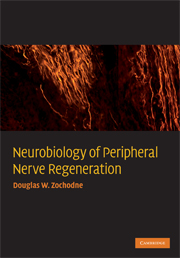Book contents
- Frontmatter
- Contents
- Acknowledgments
- 1 Introduction
- 2 The intact peripheral nerve tree
- 3 Injuries to peripheral nerves
- 4 Addressing nerve regeneration
- 5 Early regenerative events
- 6 Consolidation and maturation of regeneration
- 7 Regeneration and the vasa nervorum
- 8 Delayed reinnervation
- 9 Trophic factors and peripheral nerves
- 10 The nerve microenvironment
- References
- Index
- Plate section
- References
4 - Addressing nerve regeneration
- Frontmatter
- Contents
- Acknowledgments
- 1 Introduction
- 2 The intact peripheral nerve tree
- 3 Injuries to peripheral nerves
- 4 Addressing nerve regeneration
- 5 Early regenerative events
- 6 Consolidation and maturation of regeneration
- 7 Regeneration and the vasa nervorum
- 8 Delayed reinnervation
- 9 Trophic factors and peripheral nerves
- 10 The nerve microenvironment
- References
- Index
- Plate section
- References
Summary
The pace of molecular discovery relevant to nerve regeneration has accelerated. New insights into regeneration, however, have not necessarily been partnered with rigorous approaches to measure regeneration. The purpose of this chapter is to engender readers with a healthy appreciation of new findings, based on rigorous approaches, that confirm the complexity and beauty of the regenerative process. Similarly, the reader should be skeptical of approaches that do not live up to that standard. Assays of regeneration should ideally encompass all of the crucial steps involved in the regenerative timetable: early sprouting, axon elongation, regrowth of axon radial caliber or girth, remyelination of larger caliber axons, repopulation of nerve trunks by mature axons, and extension to target tissues. During regeneration axons regain electrophysiological properties that they have lost, features that can be carefully assayed. Finally, it is critical to know whether there has been a resumption of function, addressed through “functional” or behavioral endpoints. This chapter presents a summary of regeneration assays and a discussion of their strengths and limitations.
Structural (histological) approaches
Few other measures can convey the structural beauty of regeneration captured in a high-quality histological snapshot. Histological techniques demand strict attention toward the details of specific protocols and they require optimal handling of specimens that are appropriately sampled. Their exactitude sets a standard of quality that is enormously satisfying. Unfortunately, classical histological approaches are frequently dismissed and substituted with easier or more colorful techniques that have lower resolution.
- Type
- Chapter
- Information
- Neurobiology of Peripheral Nerve Regeneration , pp. 58 - 84Publisher: Cambridge University PressPrint publication year: 2008



